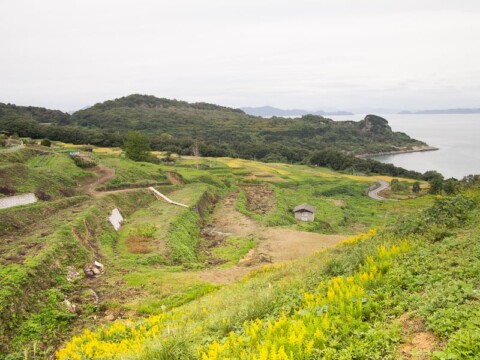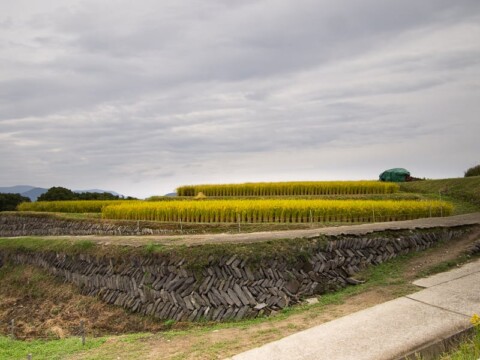Quietly, our stockinged feet touch the cool, grey floor.
Like a water droplet at the moment of landing, this concrete shell elongates. Pillarless. Seamless. Edgeless. There is no boundary between floor and ceiling.
An inclusive space. For a single, solitary artwork.
The silence is profound.
There are no cameras.
Talking is prohibited; even children’s voices hush to whispers.
Mindfully, reverentially, a minimum number of individuals quietly share this absorbing experience. For the set time we are given.
In tranquility, we humble our gaze.
From miniscule silvery pools of water, droplets dart, sporadically.
Others wriggle randomly into pale, thin streams.
Droplets pause in meditative stillness.
Springing from underground, water, from caps concealed as marbled balls of white
and from overhead, elliptical oculi let in the elements.
Spotlit by the sun, beads of water, gleaming like mercury, spurt furtively into rivulets.
An aperture reveals a sky of blue, a delicate ribbon, dotted with dewdrops, floating, hypnotically.
Clouds shadow by.
In the silence of this ephemeral space, the soft flutter of wings. The rustle of leaves. The murmur of insects. The slight sound of the wind. The gentle breath of the sea. Amplified, echoed.
Instinctively, we shift our gaze, alter our footsteps around the mesmerizing elements of water transforming, ponding lightly into puddles and patterns.
The congregated sit. Letting the moments still, like shiny surfaces of water.
Some lay, gazing out an oculus, observing the universe beyond
It is serene, surreal
We meditate on the elusive
Bokei (母型), the name of this artwork, was realized by a creative collaboration uniting the talents of the artist Rei Naito and Pritzker-Prize winning architect Ryue Nishizawa. For Rei Naito, Bokei (which translates [inadequately I think] as matrix) and colour are “always and simultaneously continuing to begin, and continuing to emerge.” Like all of us, as people. She has been quoted as saying, “Man is reborn moment after moment, newborn each time.” When asked how she came up with the idea for this, “a room of her own,” Rei said, “For me, creation is all about gaining real insights into the world we live in through things like this. By asking oneself, What kind of place is the earth?” In an interview with a curator at the Tokyo Metropolitan Teien Art Museum, Rei Naito said:
At the Teshima Art Museum, there are no boundaries between nature and art. They are one. You never know what will happen from one moment to the next. That is all. It tells us something about being alive. It’s different for everyone, but when I go in there, it is as if I were entering for the first time. The fact that I made it has nothing to do with it. How can I describe Matrix? It amazes and purifies. When there, I feel what I can only call fondness for the people who may be either looking intently or vaguely standing around.
Designed specifically to house only Bokei, the Teshima Art Museum is a zen fusion of environment, art and architecture. Nestled into the earth at the northern tip of the small island of Teshima on a hillside covered with terraced rice fields overlooking Japan’s Seto Inland Sea, we shared this extraordinary experience with Lynn and Ward.
The Teshima Art Museum is a linear concrete shell with no interior supports, an organic space whose waterdrop shape measures 40 metres by 60 metres. With its fluctuating ceiling height, its fullness at only 4.5 metres, the concrete shell appears to be part of the exterior landscape sloping to the sea, its oculus as ancient for observing the elements as Rome’s Pantheon. “Our idea was that the curved drop-like from would create a powerful environment in harmony with the undulating landforms around it,” writes architect Ryue Nishizawa. Open to the environment, the free-curving structure has large apertures on the surface of the shell to let in light, rain and fresh air. In addition, a dome-like structure houses the Museum shop and café.
To reach the Museum, we looped through a path that curves around a hill through open fields and a light forest overlooking the sea before narrowing toward the Museum’s entrance. The ticket you purchase is for a specific entrance time. You are allowed a limited time inside “in which nature, art and architecture coming together with such limitless harmony, conjures an infinite array of impressions with the passage of seasons and the flow of time.”
Magellan, who in high school thought about being an architect before studying engineering, was naturally intrigued by the structural challenge. The Museum’s architect Ryue Nishizawa wrote, “A space that equals nine tennis courts, has no supporting columns, and is only 4.5 meters high would normally collapse. The minimum is 10 to 15 meters, but then you lose the visual impact!” HIs solution? He had specialist Mutsuro Sasaki rewrite the software technology for the structural calculations so there would be no straight lines in the entire design.
We also wondered about the construction. A video explains how soil was mounded and coated with mortar in the shape of the shell. Then double-iron reinforcing frames for the concrete were assembled on the mound. It took 22 hours in the middle of winter for 120 concrete mixers to pour the concrete over the mound to a thickness of 25 centimetres. The concrete needed five weeks to dry. Then workers spent another six weeks digging out the soil from inside the new concrete shell. Planning started in 2004. The Teshima Art Museum, part of Benesse Art Site Naoshima, opened on October 17, 2010, with these words from Kayo Tokuda, the Museum’s curator at the time.
Our wish is that Teshima Art Museum becomes a place of hope for the future that speaks to our minds and spirits.
Do you know the word “ekphrasis?” It’s the verbal representation of visual art, what I’ve tried to do here, but in writing. And it’s impossible.
Promise us one thing. If you are ever in Japan, gift yourself a visit to the intangible boundary between art, architecture and nature at the Teshima Art Museum.
Navigation
Rei Naito was born in Hiroshima Prefecture in 1961. She gained prominence with One Place on the Earth for the Japanese Pavilion at the 47th Venice Biennale in 1997. Her other permanent installation is entitled Being Given (Kinza Art House Project on Naoshima, 2001). She’s had numerous exhibitions in Japan and overseas, and her works are in the collections of the Museum für Moderne Kunst Frankfurt am Main, the Museum of Modern Art in New York, the Israel Museum and the National Museum of Art in Osaka.
The architect Ryue Nishizawa was born in 1966 in Kanagawa Prefecture. He and Kazuyo Sejima cofounded the architectural firm SANAA, which is in Tokyo. Together, they were awarded the Pritzker Prize 2010—Ryue is the youngest person ever to receive it.
You can find out more about the Teshima Art Museum here.
The feature image is from www.lllabo.com.
Teshima Art Museum from JA+U on Vimeo.



















4 Responses
Very intrigueing how the simplicity of the water movement adds to the ambiance of the structure. The shell structure is almost mushroom cap like and the color fits with that, almost surreal yet as natural as the surrounding hills and country, extremely well done.
The concrete shell is an engineering marvel. But as intriguing is the forced seepage of water drops through the floor and its coelesance with other drops as if it were mercury. The growing puddle crawls to a lower point where it is slowly drawn back into the floor from where it came.
This is magnificent, and the accompanying poetry is certainly transportive. How long was your allotted time inside?
Such kind words, thank you. Time took on another dimension inside but as I recall it was about 15 or 20 minutes.